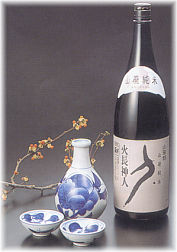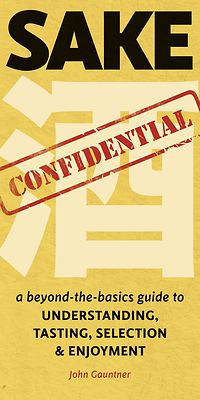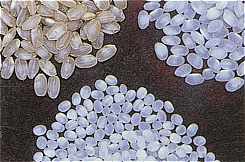Here is a visual representation of the grades of sake. The higher levels represent the higher grades of sake; higher quality, higher price, and in general, more elegant, refined, fragrant, light, and enjoyable aromatic and flavor profiles.
Here is another version of the below information, in a bit more details. The pyramid is my pride and joy, and took me years to create. All you need to know about sake is somewhere on this pyramid! Feel free to download this version!
| Ranking | No added alcohol | Some added alcohol |
 |
Junmai Daiginjo-shu A subclass of junmai ginjo-shu, brewed with very highly polished rice (to at least 50%** see below) and even more precise and labor intensive methods. The pinnacle of the brewers’ art. Generally light, complex and fragrant. |
Daiginjo-shu A subclass of ginjo-shu below, brewed with very highly polished rice (to at least 50%** see below) and even more precise and labor intensive methods. The pinnacle of the brewers’ art. Generally light, complex and quite fragrant. |
| Junmai Ginjo-shu Brewed with labor-intensive steps, eschewing machinery for traditional tools and methods, using highly polished rice (at least 60%**) and fermented at colder temperatures for longer periods of time. Light, fruity, refined. |
Ginjo-shu Brewed with labor-intensive steps, eschewing machinery for traditional tools and methods, using highly polished rice (at least 60%**) and fermented at colder temperatures for longer periods of time. Light, aromatic, fruity, and refined. |
|
| Junmai-shu Made with only rice, water and koji mold. The rice used must be polished to at least 70%**. Often a full and solid flavor profile, clean and well structured.Note also Tokubetsu Junmai-shu, or “Special Junmai-shu,” which merely indicates more highly polished rice, or the use of very special sake rice. |
Honjozo-shu Made with rice, water, koji and a very small amount of pure distilled alcohol (“brewers’ alcohol”) to help extract flavor and aroma. Light, mildly fragrant, easy to drink. |
Note also Tokubetsu Honjozo-shu or “Special Honjozo-shu,” which merely indicates more highly polished rice, or the use of very special sake rice. Sake in the six classifications above is known collectively as “tokutei meishoshu,” or “special designation sake,”and can for all intents and purposes be considered “premium sake.” It constitutes only about 20% of all sake produced. Sake in the top four boxes is collectively known as “ginjo-shu” and can be considered “super-premium sake.” (Yes, normal ginjo-shu is one subclassificaiton of the overall grouping ginjo-shu. It is only mementarily confusing!) Ginjo-shu and its subclasses constitute only the top 6% of all sake produced, and represents the pinnacle of the brewers’ craft.
Futsuu-shu 
Futsuu-shu is “normal sake,” i.e. sake that does not qualify for one of the above three levels of classifications. It is the equivalent of “table wine” in the wine world, and makes up about 80% of all sake that is made. Sake like this is produced with copious amounts of pure distilled alcohol added to increase yields. Although a lot of futsuu-shu is cheap, nasty, and vile, there is plenty of sake in this group is perfectly and enjoyably drinkable. One should avoid collectively dismissing futsuu-shu as rotgut.
While some cheaper sake in this group also has sugars and organic acids added to “improve” the flavor (better futsuu-shu does not), note that no sake at all has any preservatives added to it.
Note: There is much overlap between above classifications
There are very fragrant junmai-shu, mellow and subdued daiginjo, very complex honjozo-shu, and everything in between. The classifications are really of only moderate usefulness because of this. Your palate and preferences are really the only true way to judge quality!
About added alcohol
Cheap sake has copious amounts of distilled alcohol added to it at the final stages to increase yields. In the premium grades of sake, those above futsuu-shu, the three classifications on the left side (junmai-shu, junmai ginjo-shu, junmai daiginjo-shu), i.e. anything with the word “junmai” in it, has been made with rice only; no distilled alcohol has been added at all. This is the original and tradional method of brewing sake.
However, sake on the right side of the chart (honjozo-shu, ginjo-shu, daiginjo-shu), has had a very small amount of alcohol added to it at the final stages of brewing. This is not to increase yields, but rather the use of alcohol in this very controlled manner helps, claim some brewers, to pull out more aromatic and flavorful compounds that are soluble in alcohol from the fermenting mash when the completed sake is pressed away from the unfermented solids. It is a perfectly valid way to make great sake; it is in the end just one more method.
About Rice Polishing
In general, the more the rice used in brewing is milled before being used, the higher the grade of sake. In fact, this is the clearest definition of the ascending grades of sake. In short:
Junmai-shu and Honjozo-shu
These are made with rice that has been “polished” (as the industry puts it), or milled, to remove at least the outer 30% of the original size of the grains. This means that each grain of rice is only 70% or less of its original size.
Junmai Ginjo-shu and Ginjo-shu
These are made with rice that has been “polished” (as the industry puts it), or milled, to remove at least the outer 40% of the original size of the grains. This means that each grain of rice is only 60% or less of its original size.
Junmai Daiginjo-shu and Daiginjo-shu
These are made with rice that has been “polished” (as the industry puts it), or milled, to remove at least the outer 50% of the original size of the grains. This means that each grain of rice is only 50% or less of its original size.
Note the emphasis on the point that the numbers expressed for each grade are minimums. Very often the rice is polished much, much more than the minimum requirement. For example, it is quite common to find daiginjo that is made with rice polishedto 35%, so that a full 65% of the outside of each grain has been milled away before brewing. That means they grind away almost two thirds of their raw materials before beginning to brew. (To see how they do this, and the machines they use, go here.)
Note they do not throw away the powder that is ground away, but rather sell it to makers of traditional confectionaries and crackers, and some of it goes to animal feed. So none is wasted, but it is not used in the brewing process.
What is this all about? Why mill the rice so much?
In proper sake rice (which is different from normal table rice), starches – which is what eventually ferments – are
concentrated in the center of the grains of rice. Surrounding this, closer to the surface of the rice grains, are found fats and proteins and things that adversely affect fermentation and in general lead to off-flavors, strange and generally unwanted components to the profile.
By milling the rice further and further, more and more of these unwanted fats, protiens, and nasties can be ground away before fermentation begins. This leads to cleaner, more elegant and more refined sake. It also allows more lively aromatics to come about.
So, in general, the more you polish the rice, the higher the grade of sake. I emphasize in general because there are exceptions based on style, personal preference, and a plethora of other factors. It is possible to take this rice milling thing too far, and grind away all distinction and uniqueness as well.
Rice milling – Seimaibuai
Premium sake is brewed with special rice in which the starch component (the shinpaku or “white heart”) is concentrated at the center of the grain, with proteins, fats, and amino acids located toward the outside. For more on special sake rice, please click here. With increased milling, one can remove more of the fats, proteins, and amino acids that lead to unwanted flavors and aromas in the brewing process. Ginjo-shu (premium sake) has at least 40% or more milled away. Daiginjo (super premium sake) has at least 50% or more milled away.
[cryout-multi][cryout-column width=”1/3″]
Yamada Nishiki Rice
A top-grade sake rice
Unmilled
[/cryout-column][cryout-column width=”1/3″]
45% Milled Away
Seimaibuai = 55%
Ginjo Grade
[/cryout-column][cryout-column width=”1/3″]
55% Milled Away
Seimaibuai = 45%
Daiginjo Grade
[/cryout-column][/cryout-multi]
There is no need to go to the top to enjoy good sake
 There is plenty of immensely enjoyable sake not in the top of the top classifications. In fact, sometimes such sake has more presence, uniqueness, and appeal than super dooper hoity toity high priced daiginjo. Well, sometimes, anyway. Top of PageSake is almost always fairly priced.
There is plenty of immensely enjoyable sake not in the top of the top classifications. In fact, sometimes such sake has more presence, uniqueness, and appeal than super dooper hoity toity high priced daiginjo. Well, sometimes, anyway. Top of PageSake is almost always fairly priced.
You generally get what you pay for with sake. Up to a reasonable limit, if you pay 25 % more for sake B then sake A, you can expect about a 25% increase in quality and enjoyment (assuming that the particular “quality” increase in that particular sake is what you are looking for and prefer!). There are exceptions: there is some sake that is a bit pricey due to its lofty reputation. There are also a few tremendous bargains out there. But for most sake, those not extremely expensive or extremely cheap, you will see an increase in quality that for the most part parallells the increase in price.Note, speculation by the market and the opinion of “experts and critics” does not affect at all the market price of sake in Japan. Which is nice.
The “-shu” suffix, by the way, simply means “sake,” and is often dropped when discussing sake. Hence, Junmai-shu is sometimes called simply Junmai, Honjozo-shu is very often called Honjozo. Similarly, people speak of ginjo, junmai-ginjo, daiginjo and junmai daginjo.
 SAKE CONFIDENTAL
SAKE CONFIDENTAL
Interested in learning more about sake?
Check out my book “Sake Confidential” on Amazon.
Sake Confidential is the perfect FAQ for beginners, experts, and sommeliers.
Indexed for easy reference with suggested brands and label photos. Includes:
- Sake Secrets: junmai vs. non-junmai, namazake, aging, dry vs. sweet, ginjo, warm vs. chilled, nigori, water, yeast, rice, regionality
- How the Industry Really Works: pricing, contests, distribution, glassware, milling, food pairing
- The Brewer’s Art Revealed: koji-making, brewers’ guilds, grading
SAKE INDUSTRY NEWS
If you are interested in staying up to date with what is happening within the Sake Industry and also information on more advanced Sake topics then Sake Industry News is just for you!
Sake Industry News is a paid subscription newsletter that is sent on the first and 15th of each month. Get news from the sake industry in Japan – including trends, business news, changes and developments, and technical information on sake types and production methods that are well beyond the basics – sent right to your inbox. Subscribe here today!
Each issue will consist of four or five short stories culled from public news sources about the sake industry in Japan, as well as one or more slightly longer stories and observations by myself on trends, new developments, or changes within the sake industry in Japan.






